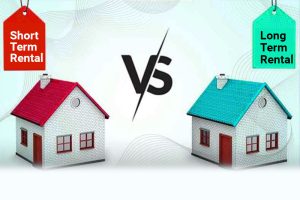
Investing in rental properties can be a lucrative endeavor, but how do you ensure maximum returns on your investment?
Understanding and calculating rental yield is crucial to making informed decisions in your property investment journey.
In this guide, we’ll provide a comprehensive overview of rental yield, its types, factors that can affect it, and various strategies to achieve high-yielding properties.
Buckle up as we dive into the world of rental yield calculation!
Short Summary
- Rental yield is a measure of return on investment in property, calculated as either gross or net yield.
- Factors such as location, condition and market trends can affect rental yields.
- Professional services and calculation tools help investors optimize their investments for high yields.
Definition of Rental Yield
 Rental yield is the income generated from an investment property, expressed as a percentage of the property’s value. It is crucial to understand that there are two types of rental yield figures – gross yield and net yield.
Rental yield is the income generated from an investment property, expressed as a percentage of the property’s value. It is crucial to understand that there are two types of rental yield figures – gross yield and net yield.
Gross rental yield is calculated before expenses are subtracted, while net rental yield takes costs into consideration. The ultimate choice between gross and net rental yield calculations depends on your preference and investment strategy.
While positive gearing occurs when the rental income generated from a property is enough to cover the associated costs of ownership, negative gearing happens when the rental income falls short of covering the property’s expenses.
A rental yield calculator can be a helpful tool for property investors to quickly determine the rental yield of a property.
Understanding Yield Calculation
 To calculate rental yield, it’s essential to understand the various types of yields and the factors that can affect them, such as property location, condition, and market trends. Yield signifies the cash flow returned to the investor annually, typically expressed as a percentage. Gross rental yield is determined by dividing the annual rental income by the property value, while net rental yield is computed by taking the annual rental income, subtracting the annual expenses, and then dividing the result by the property value.
To calculate rental yield, it’s essential to understand the various types of yields and the factors that can affect them, such as property location, condition, and market trends. Yield signifies the cash flow returned to the investor annually, typically expressed as a percentage. Gross rental yield is determined by dividing the annual rental income by the property value, while net rental yield is computed by taking the annual rental income, subtracting the annual expenses, and then dividing the result by the property value.
In analyzing yield results, investors must consider the equilibrium between yield and risk. High rental yields may signify an elevated risk of vacancy or other factors. Additionally, investors should bear in mind the potential for real estate growth when evaluating a good rental yield.
Types of Yields Calculations
There are various types of yield calculations available, such as gross rental yield, net rental yield, and yield to maturity for bonds. Gross rental yield measures the income generated from an investment property before any expenses are deducted. On the other hand, net rental yield is the amount of rental income that remains after all associated expenses have been paid out. Yield to maturity for bonds, meanwhile, is calculated as the annual interest payment divided by the face value of the bond.
Understanding the different types of yield calculations can help property investors make more informed decisions, depending on their investment goals and strategies.
Factors Affecting Rental Yield
Several factors can impact rental yield, such as property location, condition, and market trends. The location of a property plays a critical role in determining rental yield, as it can have an impact on the demand for rental properties in the area. Property condition is another crucial element, as it can affect maintenance and repair requirements, as well as the appeal of the property to prospective tenants.
Market trends, such as population growth, economic conditions, and housing supply, can also influence rental yield. When calculating rental yield, it’s important to consider expenses like taxes, insurance, and maintenance.
Calculating Gross Rental Yield
 Gross rental yield provides a simple way to measure the income generated from an investment property without taking expenses into account. To calculate the gross rental yield, it’s calculated by dividing the annual rental income by the property value and multiplying the result by 100. While this calculation is straightforward and easy to understand, it doesn’t provide a complete picture of the property’s performance, as it doesn’t account for ongoing expenses.
Gross rental yield provides a simple way to measure the income generated from an investment property without taking expenses into account. To calculate the gross rental yield, it’s calculated by dividing the annual rental income by the property value and multiplying the result by 100. While this calculation is straightforward and easy to understand, it doesn’t provide a complete picture of the property’s performance, as it doesn’t account for ongoing expenses.
This is where net rental yield comes into play. It takes into account all the expenses associated with owning and managing a property, such as mortgages.
Annual Rental Income
Annual rental income refers to the total rent collected from a property over a year. This income is a crucial component in calculating rental yield, as it forms the numerator of the rental yield formula. To calculate the annual rental income, simply multiply the weekly rental income by 52.
Keep in mind that fluctuations in rental income can have a significant impact on your rental yield, so it’s essential to monitor and adjust your rental rates as needed.
Property Value Impacting Real Estate Rental
 Property value has a direct impact on rental yield, as it forms the denominator of the rental yield formula. Generally, higher property values lead to decreased yields, as the rental income makes up a smaller percentage of the property’s value.
Property value has a direct impact on rental yield, as it forms the denominator of the rental yield formula. Generally, higher property values lead to decreased yields, as the rental income makes up a smaller percentage of the property’s value.
By understanding the relationship between property value and rental yield, investors can make more informed decisions when choosing investment properties and setting rental rates.
Another key factor is demand and supply. If there is a lot of demand for rental properties in an area, investors can often charge higher rents, leading to greater yield. On the other hand, if there is less demand and more supply in the market, it’s likely that yields will be lower.
Currently in Australia, the property market is highly varied, with some areas experiencing high demand and rising prices, while others are more subdued. Therefore, investors should conduct thorough research into local markets to determine their potential rental yields.
In calculating Net Rental Yield for properties, it’s important to consider the relationship between property value and rental yield. This can help investors make better decisions for real estate investors
Net rental yield offers a more comprehensive picture of a property’s performance, as it accounts for annual expenses and vacancy rates. To calculate net rental yield, subtract the annual expenses from the annual rental income, divide the result by the property value, and multiply by 100.
This calculation provides a more accurate assessment of the property’s financial viability, taking into account the purchase price, and can help investors make better-informed decisions about their investments.
Annual Expenses
Annual expenses, also known as property expenses, are the costs incurred in owning and operating a rental property, such as maintenance, taxes, insurance, and management fees. These expenses can significantly impact the net rental yield of a property and should be carefully considered when making investment decisions.
It’s important to have a clear understanding of all the expenses associated with a property to make accurate net rental yield calculations and optimize your investment returns. Knowing the total annual expenses can also help you compare properties and decide which one offers the best rental income potential.
Unexpected Property Investment Expenses
With new or old properties, there will always be the unexpected maintenance costs. On top of the regular expenses, things like repairing a leaky roof, replacing appliances and upgrading plumbing and electrical systems can quickly add up. Additionally, depending on where you’re located there could be additional taxes or fees that property owners need to pay.
One of the advantages of buying a brand new property, for at least the first few years, the much of the unexpected failures should be covered by warranties.
Adjusting for Vacancy Rates
Vaca that come with a rental property investment by setting residency property’s profitability, investors are better able to make informed decisions about their investments. With SurferSEO’s Annual Expenses calculator, it’s easy to get an rates are an important factor to consider when calculating net rental yield, as they account for the time when the property is unoccupied and not generating rental income. To adjust for vacancy rates, start by estimating the number of weeks or months of vacancy per year and factor this into your annual rental income calculation.
Adjusting for vacancy rates provides a more accurate net rental yield calculation and helps investors make better-informed decisions about their property investments.
Analyzing Yield Results
 Analyzing yield results are crucial for investors to recognize favourable yields and strike a balance between yield and risk. This process requires evaluating the different types of yields, such as gross and net rental yield, as well as considering factors like property location, condition, and market trends.
Analyzing yield results are crucial for investors to recognize favourable yields and strike a balance between yield and risk. This process requires evaluating the different types of yields, such as gross and net rental yield, as well as considering factors like property location, condition, and market trends.
By carefully examining yield results, investors can make strategic decisions to optimize their investment portfolios and achieve their overall investment goals.
Identifying Good Yields
 Identifying good yields is essential for optimizing your property investments. Good yields depend on various factors, such as property location, type, and investment goals. Investors should consider these factors and compare their potential investments’ yields with market averages to determine if they are achieving good yields.
Identifying good yields is essential for optimizing your property investments. Good yields depend on various factors, such as property location, type, and investment goals. Investors should consider these factors and compare their potential investments’ yields with market averages to determine if they are achieving good yields.
By identifying good yields, investors can focus on properties with higher potential returns and better align their investments with their overall investment goals.
For example, investors with a long-term focus can look for strong yields that are likely to remain consistent over time. On the other hand, investors who want to capitalize on short-term opportunities may opt for investments with higher potential for returns in the near future.
It is also important to examine yield results from different points of view. Investors should consider their own risk tolerance when evaluating yields, as some investments may come with higher risks than others. Additionally, yield results should be analyzed in the context of market trends to identify areas that are likely to experience growth or declines in returns over time.
Finally, investors should conduct a full analysis of their portfolio and assess whether it is meeting their investment goals. This process involves weighing the benefits of individual investments against the cost of maintaining them, and determining whether the returns justify the risks. By assessing yield results in this way, investors can ensure that their portfolios are as profitable as possible while minimizing potential losses.
Balancing Yield and Risk
Balancing yield and risk is an essential aspect of property investment. While high rental yields can be attractive, they may also indicate higher investment risks, such as lower capital growth or increased vacancy rates.
To balance yield and risk, investors should consider factors like property location, condition, and market trends, as well as their own risk tolerance and investment goals. By striking the right balance, investors can optimize their property investments and achieve long-term success.
Rental Yield vs Real Estate Growth
 Rental yield and property value growth are both important factors to consider when investing in real estate. While rental yield provides immediate income, real estate growth denotes long-term appreciation in value. These two factors can influence each other, as rental yield can be affected by changes in property value and vice versa. Nevertheless, they are not directly dependent on each other and can vary independently.
Rental yield and property value growth are both important factors to consider when investing in real estate. While rental yield provides immediate income, real estate growth denotes long-term appreciation in value. These two factors can influence each other, as rental yield can be affected by changes in property value and vice versa. Nevertheless, they are not directly dependent on each other and can vary independently.
Therefore, it’s essential for investors to consider both rental yield and property value growth when making investment decisions.
Is there a Relationship Between Rental Yield and Property Value
There may be a relationship between rental yield and property value, with high yields potentially indicating undervalued properties. As property values increase, rental yields tend to decrease, and vice versa. Understanding this relationship can help investors make more informed decisions when choosing investment properties and setting rental rates.
By identifying properties with high rental yields, investors may be able to capitalize on undervalued properties and achieve higher returns on their investments.
Investment Risks in High Rental Yield Properties
High rental yield properties may carry higher investment risks, such as lower capital growth or increased vacancy rates. Market conditions, location, and property type can all have an influence on capital growth and vacancy rates. Investors should carefully consider these factors when investing in high rental yield properties to ensure they are making informed decisions that align with their overall investment goals and risk tolerance.
It is important to understand the risks associated with high rental yield properties and to do thorough research before buying.
Property Investment Strategies to Achieve High Yield
 Property investment strategies to achieve high yield include government incentives, holiday home rentals, short-term vs long-term rentals, and Airbnb rentals. By understanding and implementing these strategies, investors can optimize their property investments and achieve higher rental yields.
Property investment strategies to achieve high yield include government incentives, holiday home rentals, short-term vs long-term rentals, and Airbnb rentals. By understanding and implementing these strategies, investors can optimize their property investments and achieve higher rental yields.
It’s essential to carefully consider each strategy’s advantages and challenges to determine the best approach for your specific investment goals and circumstances.
Australian Government’s Position on Property Rentals
The Australian government offers incentives for property investors, such as negative gearing and tax deductions. Negative gearing occurs when the expenses associated with owning a property exceed the rental income generated. This can be an attractive strategy for property investors looking to minimize their tax liability.
By taking advantage of these government incentives, investors can potentially achieve higher rental yields and optimize their property investments.
Holiday Home Rental Yield
Holiday home rental yield can be higher than traditional long-term rentals due to seasonal demand and higher rental rates. However, holiday home rentals may require more management and maintenance, as well as face higher vacancy rates during off-peak seasons.
Investors should carefully consider the advantages and challenges of holiday home rentals to determine if this strategy aligns with their investment goals and risk tolerance.
Short Term Rental vs Long Term Rental
 Firstly, Short Term Rentals is referred to as renting property for 3-4 months at a time, where as long term is typically 12 months and more.
Firstly, Short Term Rentals is referred to as renting property for 3-4 months at a time, where as long term is typically 12 months and more.
Short-term rentals may offer higher yields compared to long-term rentals, but may also have higher vacancy rates and require more management. Long-term rentals, on the other hand, provide more stable and predictable income with fewer tenant changes.
Investors should weigh the benefits and drawbacks of each rental strategy to determine which one best aligns with their investment goals and risk tolerance.
Some properties lend themselves better for short term rentals. Good areas to consider are;
- CBD areas
- Hospital Areas
- Commercial Areas
Improving rental yield on short term rentals
People who are looking for short-term rentals would typically do not want to furnish the property. In many cases its a home away from home. Companies or organisation would often rent it out for an employee or consultant Medical Specialist.
AirBNB Rental Yield
Airbnb rental yield can be higher than traditional rentals, but may require more management and maintenance. Additionally, Airbnb rentals are subject to local regulations and may face restrictions in certain areas. Investors should carefully consider the advantages and challenges of Airbnb rentals to determine if this strategy aligns with their investment goals and risk tolerance.
Investors should weigh the potential returns against the potential risks and costs associated with Airbnb rentals.
How to Achieve High-Yielding Properties
 Achieving high-yielding properties involves considering factors like property location, condition, and market trends, as well as utilizing professional services. By carefully selecting properties with high rental yield potential and leveraging professional services, investors can optimize their property investments and achieve their overall investment goals.
Achieving high-yielding properties involves considering factors like property location, condition, and market trends, as well as utilizing professional services. By carefully selecting properties with high rental yield potential and leveraging professional services, investors can optimize their property investments and achieve their overall investment goals.
Top 5 factors achieving High Yield Real Estate Properties
The top factors for high yield real estate properties include location, property type, condition, market trends, and management. Location plays a critical role, as properties in sought-after areas with sound infrastructure and amenities usually have higher rental yields. Property type and condition also influence rental yield, with well-maintained apartments, townhouses, and duplexes generally having higher yields than single-family homes.
Market trends, such as population growth, economic conditions, and housing supply, can impact rental yield. Effective property management is essential for achieving high-yielding properties, as it ensures the property is well-maintained and attracts quality tenants.
Professional Services to Achieve High Yield Investment Properties
Professional services, such as property managers and investment advisors, can help investors achieve high yield investment properties. Property managers can assist in optimizing rental yields by ensuring the property is well-maintained and setting appropriate rental rates.
Investment advisors can provide guidance on market trends, risks, and opportunities, helping investors make informed decisions about their property investments. By leveraging professional services, investors can maximize their rental yields and achieve their overall investment goals.
Yield Calculation Tools and Resources
 Yield calculation tools and resources, such as online calculators and investment guides, can assist investors in making informed decisions about rental yield and property investment. These tools can help investors assess rental yield, property value growth, and other important factors, allowing them to make strategic decisions and optimize their property investments.
Yield calculation tools and resources, such as online calculators and investment guides, can assist investors in making informed decisions about rental yield and property investment. These tools can help investors assess rental yield, property value growth, and other important factors, allowing them to make strategic decisions and optimize their property investments.
By utilizing yield calculation tools and resources, investors can ensure they are making the most informed decisions possible, maximizing their investment returns.
Summary
In conclusion, understanding and calculating rental yield is critical to making informed decisions in your property investment journey. By considering factors like property location, condition, and market trends, as well as employing various property investment strategies, investors can optimize their property investments and achieve high rental yields. With the help of professional services and yield calculation tools, investors can make strategic decisions that align with their overall investment goals and minimize risk. By mastering rental yield calculations and analysis, investors can unlock the full potential of their property investments and achieve long-term success.
Frequently Asked Questions

How is yield calculated on a property?
To calculate the yield on a property, simply divide the annual rental income by the purchase cost and multiply it by 100 to get the percentage of your gross rental yield. This will give you an indication of the return on your investment.
What is the formula for yield yield?
The formula for yield is to divide the income generated from the investment by the market value or initial investment, and then multiply the result by 100 to get a percentage figure.
What percentage of income is rent in Australia?
On average, Australians should aim to allocate around 25-30% of their disposable income towards rent, with 20% being the ideal target.
This is a good target to aim for, as it allows for a comfortable lifestyle while still leaving enough money for other expenses.
What is the difference between gross rental yield and net rental yield?
Gross rental yield is the return on a real estate investment calculated before expenses, while net rental yield takes these costs into account.
As such, net rental yield is more reflective of the actual financial return from an investment property.
How can I calculate annual rental income?How can I calculate annual rental income?
To calculate annual rental income, simply multiply the weekly rental income by 52.
This will give you an accurate picture of what your yearly rental income would be.













